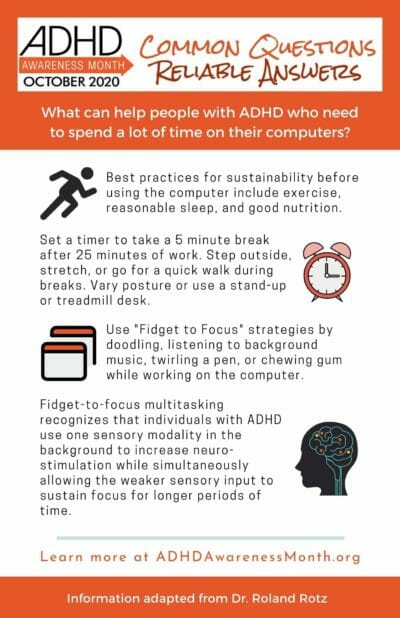Excessive screen time to the most experienced users can be a physical, mental and emotional strain to say the least. The American Optometric Association notes that the average American worker with a desk job spends at least seven hours a day looking at computer screens, which does not include leisure time use. Under the best of circumstances, ADHD folks find computer material interesting and, therefore, stimulating which allows for heightened and sustained mental focus for long periods of time. This could be a video game for hours at a time, binge-streaming a favorite tv series, a student Zooming all day in school, and a worksite that requires regular use of a computer and monitor. Under these conditions, best practices for sustainability would include exercise such as a brisk walk or moderate run, reasonable sleep, and good nutrition before getting on the computer.
While at the computer, reduce eye and body strain by adjusting the blue light of the screen to an amber or “night-time” setting. Take a break after every 25 minutes for 5 minutes, and while on the break, to reduce eye strain look away from the screen to focus on an object 25 feet away for 25 seconds. During your 5-minute break, step outside and take the dog for a quick walk around the block to stretch fatigued muscles while being mindful of yourself and breathing fully.
Consider using computer glasses to filter blue light and don’t forget to blink.
Under more challenging circumstances, we are tasked to attend to boring but important material on the computer screen. This difficulty to maintain focus suggests that it is even more important to do the 25 minutes on with a 5-minute break that takes you outdoors if possible.
A timer is a valuable tool not only to keep track of the 25 minutes but especially for sticking with the 5-minute break. Other strategies include varying posture or standing up, which can be accomplished by using stand-up desks or treadmill desks.
Consider using “Fidget to Focus®” strategies to assist focus on tedious computer material. Fidget-to-focus multi-tasking recognizes that ADHD folks use one sensory modality in the background to increase neuro-stimulation while simultaneously allowing the weaker sensory input to sustain focus for longer periods of time. This could be doodling while listening to a lecture, listening to music in the background while working on the computer, twirling a pen or playing with a “Tangle-toy” while watching a screen, or chewing gum or munching on carrots while listening to a pre-taped lecture on the computer.
It also helps to reduce unintended distractions by turning off social media and internet sites while working at the computer.
So, whether viewing interesting or tedious material on computer screens for long periods of time, the very action can be physically, mentally, and emotionally stressful. Fortunately, many simple to use strategies are easily accessible, readily available, and offer relief.
About the Author

Roland Rotz, Ph.D., is a clinical psychologist, and director of the Lifespan Development Center in Carpinteria, CA. For over 30 years Dr. Rotz has focused on providing quality diagnostic and clinical services to children and adults, particularly those with ADHD.

